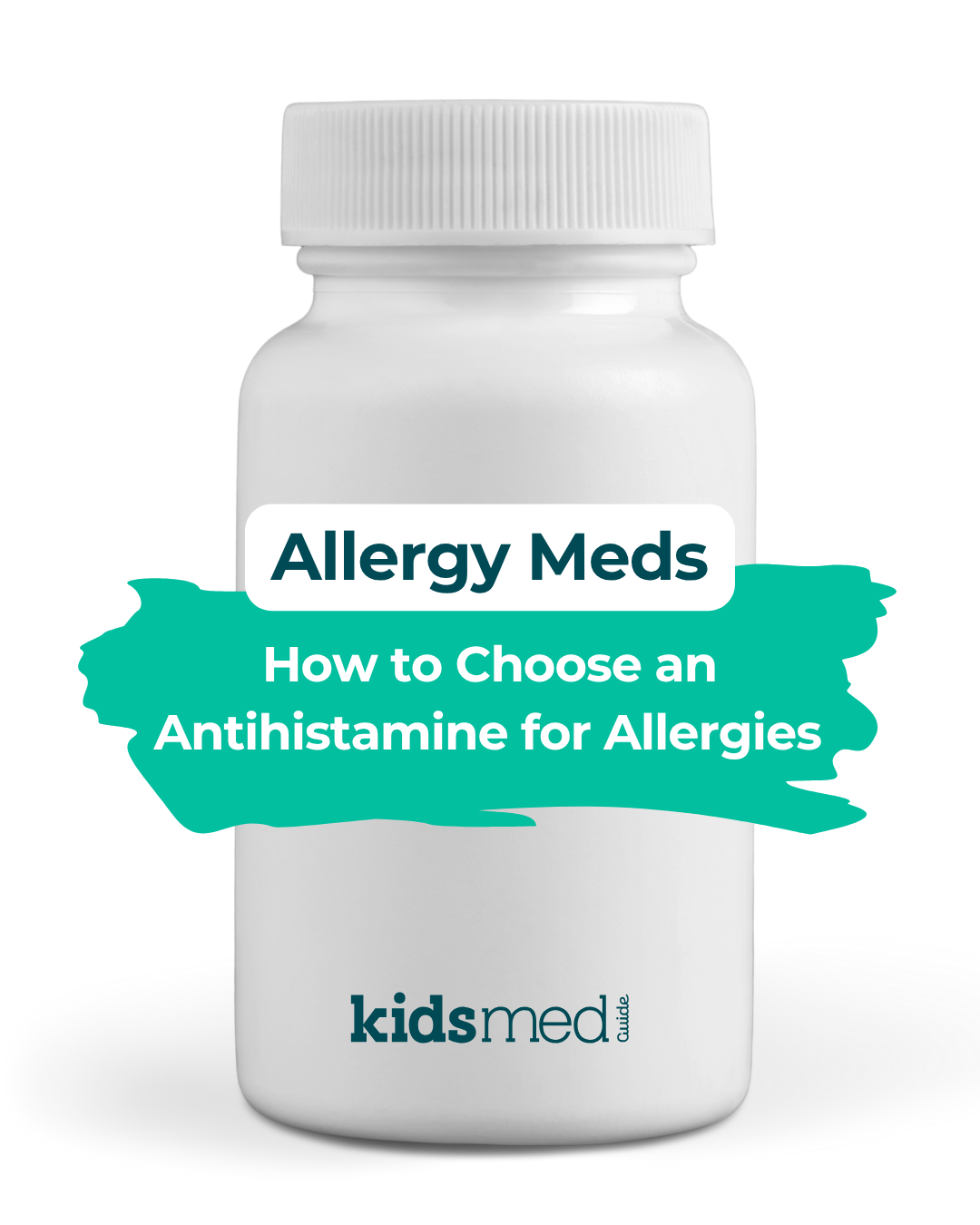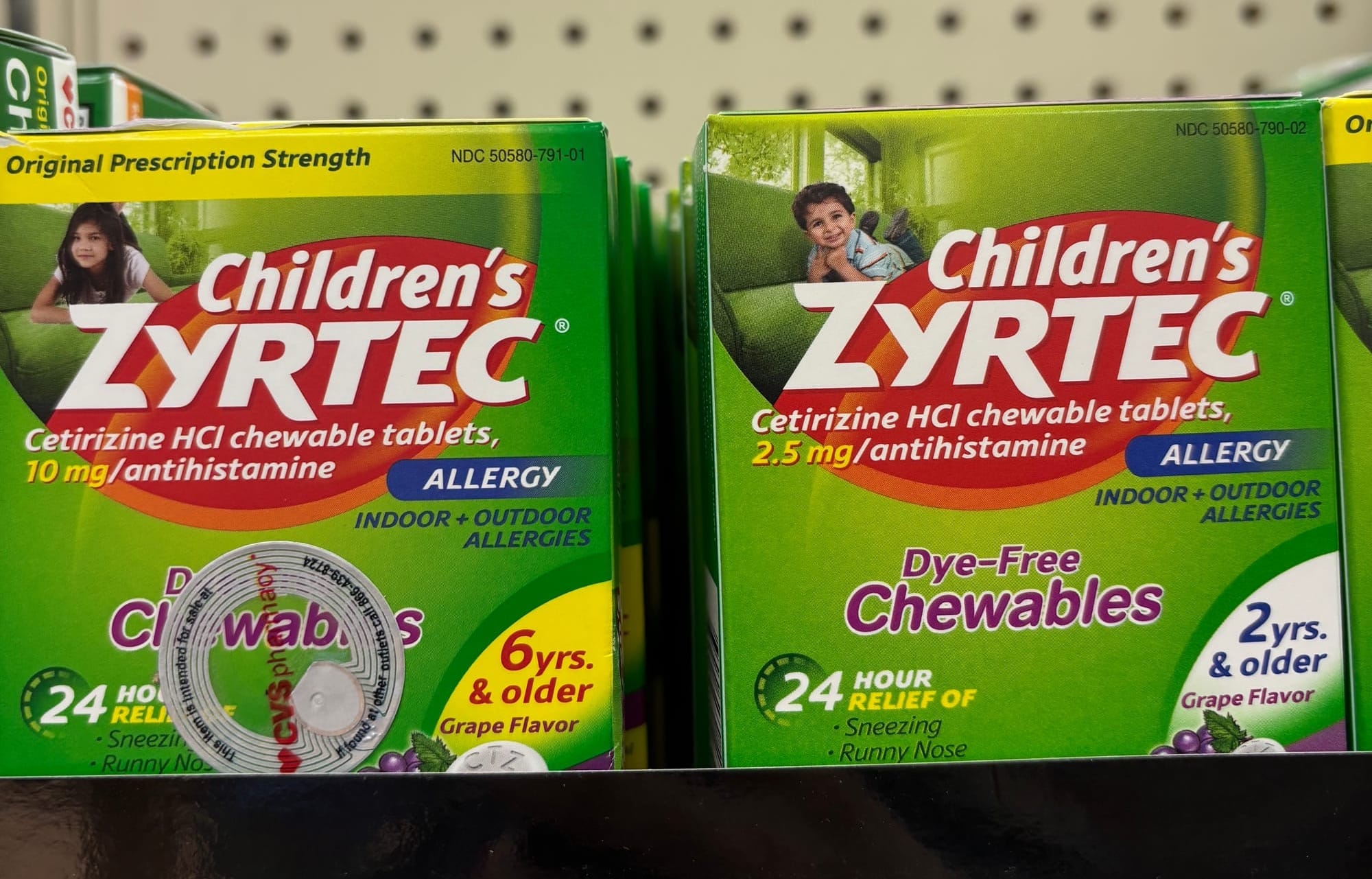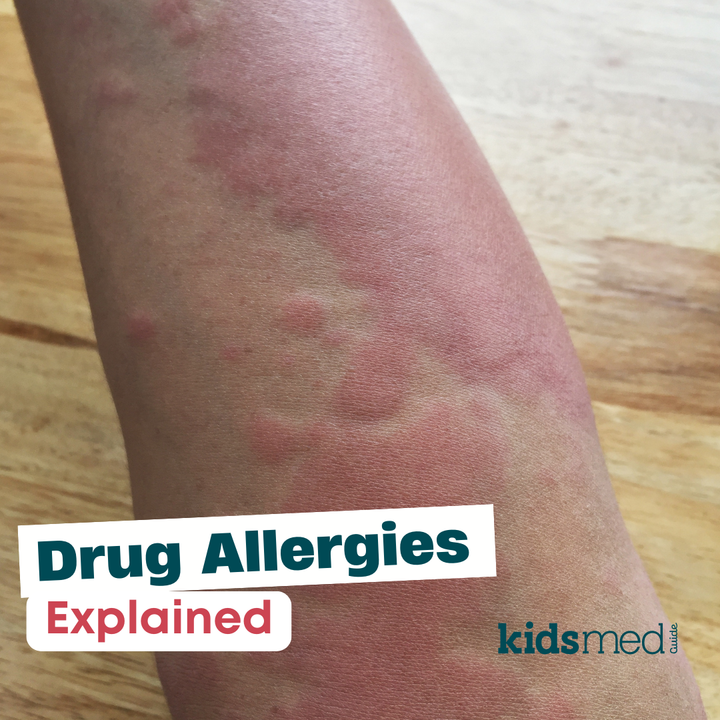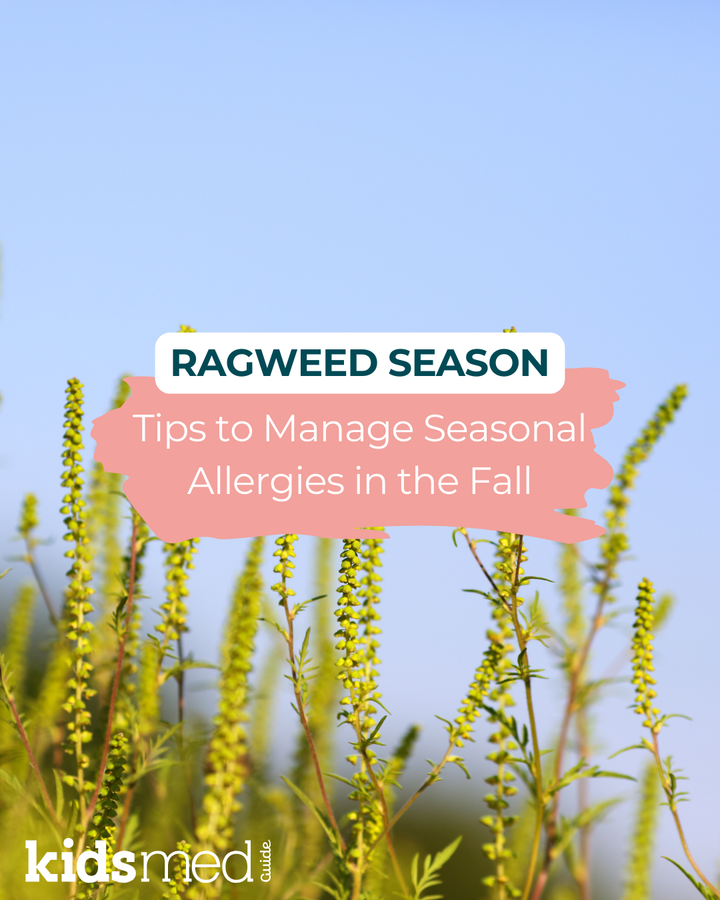Allergy Medicine: What's the Difference Between Antihistamines?

If your child is suddenly sneezing more than a cartoon cat in a feather factory (channeling my inner Dad Joke), you're probably thinking about allergy medicine. This spring has been pretty brutal where I live. Everyone is complaining about the pollen.
Anyone who suffers from seasonal allergies knows they need relief, and that's especially true if the allergy sufferer is a tiny human! But with so many over-the-counter options—Zyrtec, Claritin, Benadryl—how do you choose which one is best for your kid?
What are Antihistamines?
Antihistamines are one of the cornerstone medication classes used to treat seasonal allergies. Histamine is a chemical in the body that is released in response to a trigger, such as an environmental allergen like pollen. Histamine has numerous effects on the body, and some of the more well-known effects include inflammation, sneezing, a runny nose, and nasal congestion. AKA - allergy misery.
An antihistamine will block or lessen the histamine response inside the body. In the case of pollen and other seasonal allergies, taking an antihistamine daily during allergy season helps manage histamine release and, over time, lessen symptoms.
Several antihistamine products are available for purchase over the counter. We'll discuss some of the more common options.
Zyrtec® (Cetirizine)
Zyrtec is a second-generation antihistamine, which means it’s less likely to cause drowsiness than first-generation options, such as Benadryl. It starts working within 1 hour and provides 24-hour relief.
It's approved for children as young as 6 months but typically should only be used in kids for OTC allergy relief for ages 2 years and older (infants should see their pediatrician if parents suspect allergy medicine is needed). Zyrtec is taken once a day, and the daily dose is based on the patient's age.
Zyrtec can be used safely at home to manage seasonal allergies in children. Healthcare providers may also use it to help manage severe allergic reactions or could prescribe it for different skin conditions.
Of the second-generation antihistamines, Zyrtec may be the most sedating option. However, individuals may respond differently to different drugs in terms of tolerance.
Zyrtec is available in liquid, tablet, orally disintegrating tablet, or chewable tablet formulations. Generic cetirizine products are also available, are just as effective, and may be cheaper!
A quick safety note for all antihistamines:
Use caution when purchasing, as tablets and chewable tablets may come in different strengths and are intended for various age groups, but their packaging often looks very similar. I was shopping recently and almost grabbed the wrong box for my 3-year-old. (In the pharmacy world, we call this a potential for a "look-alike/sound-alike" error).
Take a look!

Claritin® (Loratadine)
Claritin is also a second-generation antihistamine, typically less sedating than Zyrtec and Benadryl. If your child struggles with sleepiness from Zyrtec, Claritin may be a better option!
It has a slower onset (up to 3 hours) but still offers once-daily dosing. The dose is based on the patient's age. Claritin is not used to manage severe allergic reactions.
Claritin is available in tablet, liquid, orally disintegrating tablet, and chewable tablet forms. Generic loratadine products are also available, are just as effective, and may be cheaper!
Allegra® (Fexofenadine)
Allegra is another second-generation antihistamine that is less sedating than Benadryl. Allegra is approved for treating allergies in children. It's given twice daily instead of once a day. It typically starts to work within an hour of ingestion. The primary indication for Allegra is the treatment of seasonal allergies; however, a doctor may also prescribe it for specific skin conditions.
Allegra comes in liquid, tablet, and orally disintegrating tablet formulations. The tablet and orally disintegrating tablets are intended for children aged six and above. The liquid is suitable for children aged 2 and older.
Benadryl® (Diphenhydramine)
Benadryl is a first-generation antihistamine and is well-known for causing drowsiness. It works quickly (usually in under 30 minutes or so, depending on the dosage form) but requires dosing every 4–6 hours.
Due to its sedating effects, it’s usually not recommended as a daily allergy medication. Use Benadryl for short-term relief (e.g., allergic reactions, hives) under guidance from your pediatrician. A healthcare provider may also use Benadryl to manage a severe allergic reaction.
The dose of Benadryl varies based on the patient's age and weight. Benadryl comes in tablet, capsule, and liquid forms. Benadryl is also sometimes recommended as a sleep aide for motion sickness or to help manage anxiety or agitation. While Benadryl is available over-the-counter, it should only be used for these indications if instructed to by a physician.
In children, Benadryl can cause a phenomenon known as a paradoxical reaction. This means that instead of getting sleepy or drowsy, your kid gets wired and hyper! This is another reason we recommend safer, second-generation antihistamines for treating allergies. We also do NOT recommend Benadryl as a sleep aid. It's not proper sleep hygiene, and no one needs an amped-up child 😦
Quick Comparison of Antihistamines
- Zyrtec: Fast onset, may cause drowsiness, given 1x/day
- Allegra: Medium onset, less sedating, given 2x/day
- Claritin: Slower onset, least sedating, given 1x/day
- Benadryl: Fast acting, very sedating, given 3–4x/day, not usually recommended for treatment of seasonal allergies
Antihistamine Similarities
- All available over-the-counter without a prescription
- All available in generic form:
- Claritin = loratadine
- Zyrtec = cetirizine
- Allegra = fexofenadine
- Benadryl = diphenhydramine
- All have a general minimum age of 2 years,
- Exception: Benadryl, which should not be used in children under 6 years of age unless prescribed by a healthcare provider
- In some circumstances, doctors may recommend using antihistamines in infants aged 6 months and up
- All come in multiple dosage forms, such as tablets, chewable/disintegrating tablets, or liquid
- All may cause some drowsiness; consider dosing at night or trying a different antihistamine if drowsiness is an issue
- For the treatment of seasonal allergies, such as pollen in the spring, it typically takes a couple of weeks to reach peak effectiveness and symptom relief. This is due to continual exposure to allergens and the time it takes to mitigate the histamine response.
- All must be taken consistently during allergy season to have the best effect
- All can be used in combination with other allergy medications, such as steroid nasal sprays or allergy eye drops
- All are safe with minimal side effects when used as directed in healthy children
When to Use Which
- For daily seasonal allergies, start with any of the second-generation antihistamines, such as Claritin, Allegra, or Zyrtec. If one doesn’t work, try another! If you've tried two different options with no success, it's time to see the doctor. There may be a prescription option that can help.
- For itchy rashes or hives, Benadryl may be better in the short term, especially at bedtime. However, if your child experiences unexplained hives or if you suspect a severe allergic reaction, consult a pediatrician or seek emergency care.
- Zyrtec may also be used for hives or allergic reactions under the care of a physician (see note above!)
- For sleep-deprived toddlers? I know it's tempting.... trust me, my kids don't sleep very well... but don’t use Benadryl as a sleep aid—it's not safe or recommended.
Dosing Tips
Always check the label for age-specific dosing. Zyrtec, Allegra, and Claritin are dosed based on a patient's age. Benadryl is dosed based on age and weight. Use a medication syringe or dosing cup for accuracy. If you're using a liquid formulation, the package should come with a dosing cup. Liquids and chewable tablets come in various flavors.
Final Thoughts
Choosing an allergy med isn’t about picking the 'best' one—it’s about deciding what works best for your child, what is accessible to you, and what is affordable. Any of the second-generation antihistamines (such as Zyrtec, Allegra, or Claritin) or their generics should be effective.
Consult your pediatrician or pharmacist if you're unsure about the best option for you. And remember, you may need to try more than one before finding the right fit!
Related:
Non-Drug Treatment Options for Seasonal Allergies
Guide to Common Childhood Allergies
Are Allergy Eye Drops Safe for Kids?
The following references were used to compile this information:
Allergy Medicine for Children. (2013, May 29). HealthyChildren.Org. https://www.healthychildren.org/English/health-issues/conditions/allergies-asthma/Pages/Allergy-Medicines.aspx
DailyMed—BENADRYL ALLERGY- diphenhydramine hydrochloride solution. (n.d.). Retrieved June 5, 2025, from https://dailymed.nlm.nih.gov/dailymed/drugInfo.cfm?setid=224ba2a3-1a93-29c8-e063-6394a90a9bef
DailyMed—CHILDREN CLARITIN ALLERGY- loratadine solution. (n.d.). Retrieved June 5, 2025, from https://dailymed.nlm.nih.gov/dailymed/drugInfo.cfm?setid=170061e9-e529-4ff0-e054-00144ff8d46c
DailyMed—CHILDRENS ALLEGRA ALLERGY- fexofenadine hydrochloride suspension. (n.d.). Retrieved June 5, 2025, from https://dailymed.nlm.nih.gov/dailymed/drugInfo.cfm?setid=e2bd23c7-dfba-463a-adbe-2183970da740
DailyMed—CHILDRENS ZYRTEC ALLERGY- cetirizine hydrochloride syrup. (n.d.). Retrieved June 5, 2025, from https://dailymed.nlm.nih.gov/dailymed/drugInfo.cfm?setid=ee8695ac-1293-4e43-ac7c-a64e21a0ca0a
Miligkos, M., Dakoutrou, M., Statha, E., Theochari, N. A., Mavroeidi, I. A., Pankozidou, Ι., Papaconstadopoulos, I., & Papadopoulos, N. G. (2021). Newer-generation antihistamines and the risk of adverse events in children: A systematic review. Pediatric Allergy and Immunology, 32(7), 1533–1558. https://doi.org/10.1111/pai.13522



